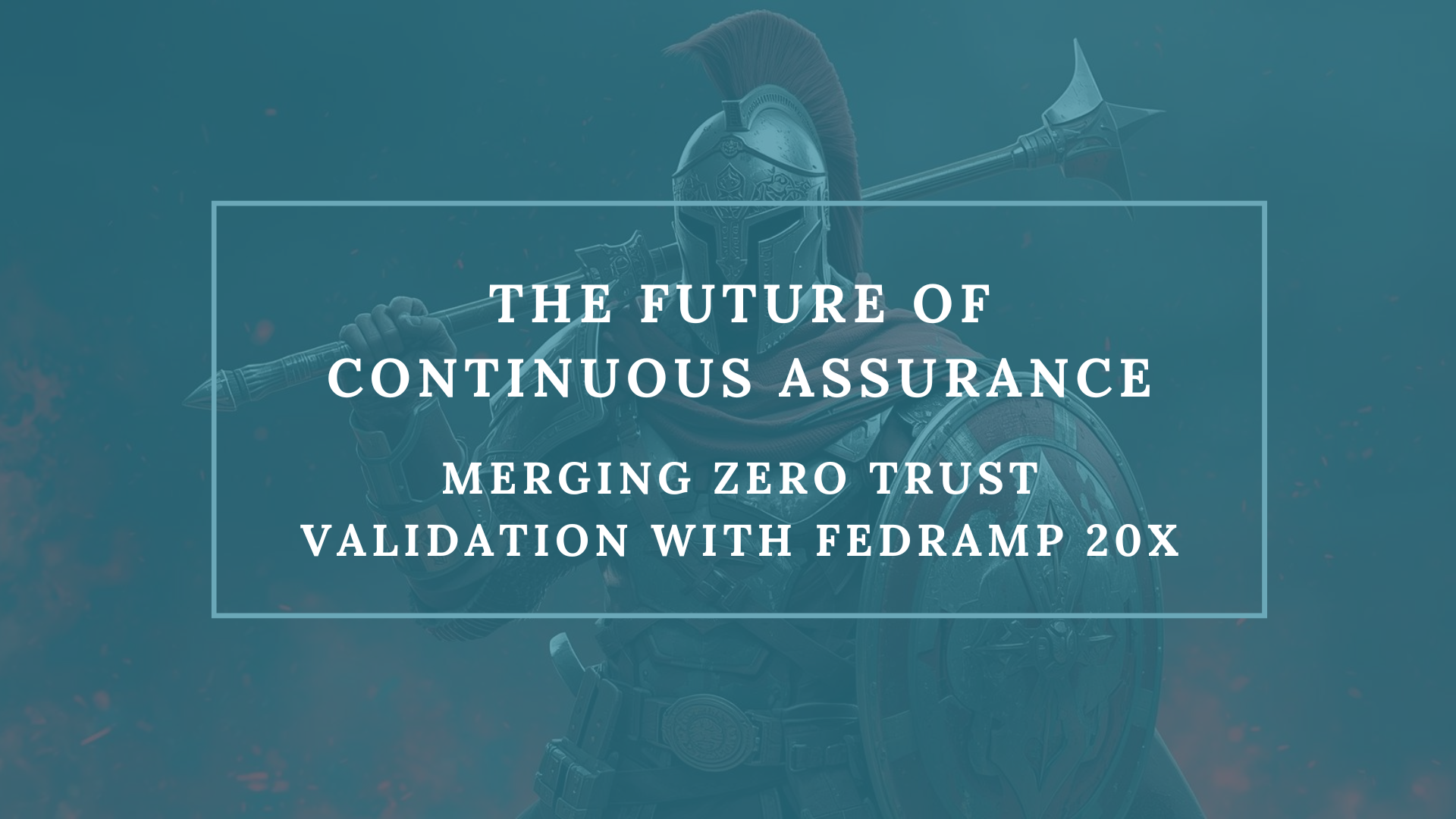The Future of Continuous Assurance: Merging Zero Trust Validation with FedRAMP 20x
The old model of static compliance and perimeter-based trust no longer suffices. In its place, we must evolve toward continuous, evidence-driven verification of trust across identities, devices, policies.
Meanwhile, the federal cloud world is undergoing its own transformation: FedRAMP 20x, launched in 2025, is the U.S. Government’s first major pivot away from traditional “paper, narrative, triple-review” toward a cloud-native, automated, continuous monitoring–centric security authorization regime.
What happens when these two paradigms collide? Does the FedRAMP 20x vision presage a future aligned with Zero Trust Validation or does it risk repeating the same old compliance theater under a new label? Let’s explore.
Why Zero Trust Validation Matters in the FedRAMP 20x Era
This new model rest on a simple but profound insight: security assurance must shift from “we claim we have controls and demonstrate compliance with screenshots” to “we continuously show that trust decisions are validated, enforced, and can adapt.” In a world of cloud, AI agents, and ephemeral identities, auditors can no longer rely on periodic snapshots they must probe the ongoing life of trust. We need to do it live with adaptable validations.
FedRAMP 20x embeds a remarkably similar logic: instead of years-long review cycles, the authorization model emphasizes continuous monitoring and automated validation of Key Security Indicators (KSIs).
From that perspective, FedRAMP 20x is not just compatible with Zero Trust validation it is, in many ways, an institutionalization of it. If done well, 20x can offer a regulated, government-scale testbed for continuous assurance approaches.
But and this is a big but there are hard design questions and tradeoffs to navigate.
Key Tensions & Design Questions
- Automation vs. Deep Insight
- FedRAMP 20x aims for 80%+ automated validation of requirements through machine-readable, testable indicators.
- But not all trust judgments can be reduced to automated checks especially in AI systems, where intent, bias, provenance, and delegation matter. The validations must go beyond “who did what” to “why, how, and under what authority” for autonomous agents.
- The danger: turning continuous validation into a shallow “green/red light” dashboard that misses deeper semantic or contextual drift.
- FedRAMP 20x aims for 80%+ automated validation of requirements through machine-readable, testable indicators.
- Evidence Granularity & Explainability
- In a Zero Trust paradigm, logs evolve into “explainability trails”, documenting not just outcomes but reasoning, policy logic, and data lineage.
- FedRAMP 20x will require machine-readable evidence supporting each KSI validation (true/false/partial) and supporting artifacts (policies, inventories, logs)
- But will that evidence carry the richness auditors need? The challenge is balancing machine-readability with semantic depth.
- In a Zero Trust paradigm, logs evolve into “explainability trails”, documenting not just outcomes but reasoning, policy logic, and data lineage.
- Decentralized Accountability
- You can’t validate the trust model from outside; the audit must mirror zero-trust, no blind spots, no implicit trust.
- Under 20x, much of the monitoring responsibility shifts to CSPs and consuming agencies, with less centralized FedRAMP oversight.
- That raises the question: how do we ensure accountability when trust decisions are executed across multiple autonomous systems, dashboards, and pipelines?
- You can’t validate the trust model from outside; the audit must mirror zero-trust, no blind spots, no implicit trust.
- Handling AI Agents & Delegation
- Validation of AI agents: were their actions consistent with policy, data provenance, human oversight, and constraints?
- FedRAMP 20x currently focuses on Low-impact systems in its pilot, and AI agent validation is not yet formalized. The next pilot is focusing on expanding the standards and Moderate-impact-systems.
- As FedRAMP 20x expands, the demand for frameworks that audit autonomous decision-makers (not just services) will only grow.
- Validation of AI agents: were their actions consistent with policy, data provenance, human oversight, and constraints?
- Drift, Signal vs. Noise, and Audit Fatigue
- Continuous monitoring uncovers constant drift. But auditors and operators must avoid drowning in alerts and false positives. Validation must evolve from reactive report checking to predictive risk intelligence. Audit the validation not just the report.
- FedRAMP’s draft Continuous Vulnerability Management Standard (RFC-0012) pushes toward more context-aware prioritization and automated response timelines.
- The balancing act: automated rigor, but smart filtering; continuous insight, not continuous alarm fatigue.
- Continuous monitoring uncovers constant drift. But auditors and operators must avoid drowning in alerts and false positives. Validation must evolve from reactive report checking to predictive risk intelligence. Audit the validation not just the report.
A Speculative Vision: Zero Trust Validation as the Heart of FedRAMP 20x
What if Zero Trust Validation became the governing philosophy behind FedRAMP 20x’s future growth? Here's a speculative trajectory:
- Trust Dashboard as the New ATO Document: Rather than producing a monolithic System Security Plan, CSPs would present a live, auditable Trust Dashboard. It synthesizes KSI status, explainability triples (action → rationale → constraints), drift metrics, and delegated AI audit trails.
- Validation Hooks & Self-Instrumentation: From Day 0, CSPs embed validation hooks into IAM, device posture, microsegmentation, policy engines, and AI agents. Every trust decision is logged, forward-linked to policies, and versioned, not as an afterthought, but by design.
- Validation Pipelines as First-Class Citizens: Continuous validation would operate like data pipelines: ingest logs, correlate signals, score deviations, invoke “mini-validation agents,” and escalate anomalies for human review. Auditors become orchestrators of validation pipelines, not checklist reviewers.
- Shared Validation Ecosystem: Agencies, CSPs, and independent assessors (3PAOs) share a federated trust fabric. Audit artifacts move between them fluidly; cross-verification emerges. The audit of one system can reuse or reference trust evidence from others reducing duplication and increasing consistency.
- Regulated Agent Audits: As AI agents take on decision-making roles, audit standards extend to agent provenance, orchestration graphs, and constrained delegation. Federated attestations ensure that agent-to-agent trust is cryptographically auditable.
If FedRAMP 20x truly embraces this vision, it could pioneer the next chapter of assurance, not just for the federal cloud, but for the broader enterprise world grappling with zero trust and AI complexity.
Are We Ready?
As Zero Trust Validation and FedRAMP 20X converge, every organization operating in the federal cloud must ask:
Are we ready for continuous assurance?
This next chapter of governance demands more than checklists it requires live, data-driven trust signals built into every layer of your system.
The Path Forward
- Invest in auditable architecture. Embed auditability, explainability, and policy traceability into your systems today, not next year.
- Engage with FedRAMP 20X working groups. Bring your real-world Zero Trust experience to the table; FedRAMP is explicitly inviting engineering-driven feedback.
- Rethink auditor skill sets. Tomorrow’s auditors must be fluent not only in governance but in data pipelines, AI reasoning, cryptographic attestation, and real-time drift analytics.
- Prototype explainability trails. For every AI agent and trust decision, capture why an action was allowed, under what logic, and with what constraints.
- Watch the pilot signals. The 20X Low pilot is just the beginning early adopters that demonstrate maturity will help define the Moderate and High baselines of the future.
Let’s Go Toward Continuous, Machine-Verifiable Trust
The conversation between Zero Trust Validation and FedRAMP 20X is not a process tweak, it’s a structural shift.
When continuous validation, live telemetry, and explainability are engineered directly into federal cloud systems, assurance becomes a living process, not a periodic exercise.
Continuous assurance is no longer an aspiration -> it’s the operational baseline for FedRAMP 20X.
We must move past Point-In-Time Authorization toward real-time, machine-verifiable trust. Every control, every AI decision, every transaction should emit proof of compliance as it happens. That’s not paperwork — that’s continuous verification by design
And maybe, just maybe, that’s how we finally achieve machine-verifiable trust, not just in our clouds, but across our entire Governance, Risk, and Compliance ecosystem.
Built by the Few Who Defend the Many
#FedRAMP20X #ZeroTrust #AI #ContinuousCompliance #XBU40 #CommandCenter #AuditShield #BuildManageDefend #Evergreen #MachineVerifiableTrust


